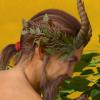Ambient value in Iray
New to Iray. With 3Delight rendering you can change the ambient value of an individual object easily enough, e.g. say you want a jacket to be lighter in tone you just adjust the ambient component of it's surface. What in general is the equivalent adjuster with iray surfaces?



Comments
What ambient does in 3DL is basically to give the surface a glow. With the standard "vanilla" 3DL it only simulates it, but if you use UE2 with bouncelight mode, adding ambient actually makes a surface emissive. Even more so if you use scripted pathtracing. So in that sense the IRay equivalent would be emissive color/strength.
Emissive, kinda-sorta. I would only use emissive for objects that actually glow, such as light bulbs.
To just make a jacket lighter you best adjust the base colour.
If the base colour is already white: For a simple (but not particularly sophisticated) fix, open the base colour map with the layered image editor. Place a plain white layer on top of your map, then adjust the opacity of said white layer to control how much lighter the surface will become.
For more sophisticated results you might have to adjust the map in an external image editor.
If you're dealing with surfaces that use translucency (such as skin) you can lighten the tone by lowering the translucency value.
Thanks, guys. I'll work on it. Much appreciated. So, Hylas, you're suggestion is basically photoshopping, one way or the other, the original material. I've often done that sort of thing, but it's so much easier with the ambient adjustment in 3Delight. Too bad. Must be some reason for iray they didn't design it in to the adjustments.
Pathtracing (such as IRay or scripted pathtracing for 3DL) is supposed to be physically correct (or plausible if you prefer that). The 3DL DS implementation has not had any significant updates for many years, still not using a linear workflow, meaning gamma correction is off by default, meaning shading is not accurate, meaning you sometimes have to use/abuse the ambient channel to correct things, but it was never intended to be used this way. Still the DAZ shop is full of 3DL presets that use ambient just as you described it. And documentation about a linear workflow is pretty much non-existant;) So, just saying, when you start working with PBR rendering you need to think more like in the real world, use light composition, tone mapping and gamma settings to get the results you want.
I could go really deep into what the Ambient channel was really designed for in the Renderman based engines like 3DL, but Sven's got it right. It was typically (mis)used by vendors as a way to add effects to surfaces.
Think about being in a dark room and shining a flashlight on the ceiling. The light bounces and lights up the whole room to some degree. In 3Delight that wouldn't happen. You'd just get a circle of light on the ceiling and the rest of the room would be dark. Ambient light was intended to imitate the idea that there is light in the environment that isn't directly attributable to a specific light source. The Ambient channel on a surface was intended to tell the engine how it should react to that light. Most of the time it was black, meaning "If no light shines directly on this, then no light is reflected." Properly it "should" have the same texture map as the diffuse channel and a gray tone multiplier to indicate how much ambient light is in the scene.
The problem was that unless you setup ALL of your surfaces in the scene to take advantage of ambient light, it ended up looking like one or two objects were "glowing". Which led people to mistakenly assume Ambient was to be used for special effects like making something "glow". And even if you did go to the effort of adjusting all your surfaces, it wouldn't look 100% right because the light was omnidirectional and could not be occluded so it had odd effects on the look of shadows, etc.
Compare this to Iray.
In Iray, if I shine a strong light on the celing it WILL bounce around the room. I might have to wait several hours for all the calculations, but eventually Iray would map out everywhere the light bounced and would add light to all those surfaces just like in the real world. For this reason, an Ambient channel isn't necessary.
One thing you could do in the Iray Uber Shader though would be to work with the top coat. Since Top Coat is added to the results of the surface after the Base, Specular, etc. effects are calculated, it would have the effect of adding to the overall surface settings. Just be careful about the strength as you could easily overwhelm the other settigs in the shader and totally mess up how your object looks.
Also, in Poser the Ambient was not multiplied with the Diffuse so it was possible to make anything glow this way, in the Default Daz Shader the multiplication is carried out so there was no need for the base maps to be applied to the ambient channel to get a more realistic effect.
Ah, I see now. It'll take some work to get familiar with iray lighting. I only have cpu rendering and thought iray would be too slow, but the results seem worth it now, and the speed is not so bad I really appreciate all your answers.